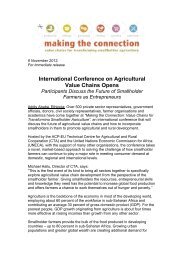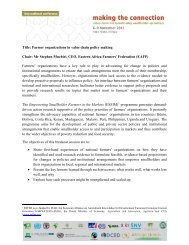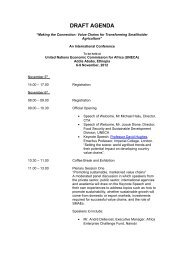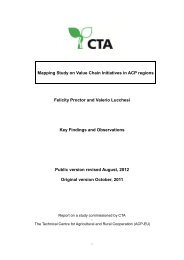Download the presentation (Merten Sievers, ILO Geneva)
Download the presentation (Merten Sievers, ILO Geneva)
Download the presentation (Merten Sievers, ILO Geneva)
Create successful ePaper yourself
Turn your PDF publications into a flip-book with our unique Google optimized e-Paper software.
Value Chain Development and<br />
Employment creation<br />
Making <strong>the</strong> Connection conference<br />
Addis Ababa November 2012<br />
<strong>Merten</strong> <strong>Sievers</strong><br />
Value Chain Development Global coordinator<br />
<strong>ILO</strong> <strong>Geneva</strong>
Structure of this session<br />
1. Where are jobs good for development?<br />
2. How can we address job creation with Value<br />
Chain development?<br />
A. VC Selection as a key to job creation<br />
B. Scale and sustainability<br />
C. Working conditions in value chains<br />
3. The Oromia Coffee Farmers Cooperative<br />
Union: how did it reach scale?<br />
4. The experience of <strong>the</strong> Nyala Dairy value<br />
chain in central Kenya
Jobs according to <strong>the</strong> World Development Report 2013<br />
Jobs for<br />
<strong>the</strong> Poor<br />
Jobs that<br />
empower<br />
women<br />
Jobs that do<br />
not shift<br />
burden<br />
Jobs in<br />
cities<br />
Living<br />
Standards<br />
/ Poverty<br />
Jobs<br />
connected to<br />
global markets<br />
Development<br />
Productivity<br />
/Enterprise<br />
development Developmen<br />
t<br />
Jobs<br />
Green<br />
Jobs<br />
Social<br />
Cohesion<br />
Jobs that<br />
provide sense<br />
of fairness<br />
Jobs that<br />
link to<br />
networks<br />
Jobs<br />
that shape<br />
social<br />
identity
Employment contribution by<br />
enterprise size:<br />
1. Jobs: where?<br />
Employment conditions by<br />
enterprise size:<br />
High<br />
quality<br />
Low<br />
quality
…being small has<br />
disadvantages…
1. Jobs: a few key issues<br />
► Massive and long lasting job creation is only<br />
possible with growth<br />
► Sustainable growth builds on functioning<br />
market systems<br />
► That provide a sense of social cohesion and<br />
value to most actors in <strong>the</strong> chain<br />
► Addressing underlying constraints in market<br />
systems becomes key
2. Value Chains and Markets<br />
Potential<br />
Business<br />
Service<br />
Markets<br />
End<br />
market<br />
Business Environment<br />
Sector-specific<br />
providers<br />
Cross-cutting<br />
providers<br />
Financial (cross<br />
cutting)<br />
Global<br />
Retailers<br />
Exporters<br />
Final Consumers<br />
Buyers<br />
Producers<br />
Input Suppliers<br />
National<br />
Retailers<br />
Wholesalers<br />
Internal<br />
Value<br />
Chain<br />
markets
Agriculture,<br />
Tourism<br />
<strong>ILO</strong>s VCD project portfolio<br />
Textile<br />
Timber,<br />
Construction<br />
Skills in<br />
VCD<br />
Construction, Tourism,<br />
Community Services, Agroprocessing<br />
Horticulture<br />
EnterGrowth<br />
LED/VCD<br />
Rattan<br />
Bamboo<br />
Meat,<br />
Horticulture
The Bamboo Value Chain<br />
in Vietnam<br />
Source: Oxfam Hong Kong<br />
Bamboo laminated<br />
flooring and panels<br />
Fuel<br />
Pellets<br />
Blinds Building products
A. Sector/VC selection as a crucial step for<br />
job creation<br />
Relevance to <strong>the</strong> poor?<br />
(MSEs, women, workers)?<br />
High number of poor or<br />
disadvantaged groups (poor<br />
close to markets: producers,<br />
workers, consumers)<br />
Intervention potential?<br />
Feasibility of stimulating<br />
value chain development for<br />
Decent Work through<br />
systematic market change<br />
Poverty and Employment<br />
change potential?<br />
„Stepping-up“<br />
(productivity, market<br />
share, work quality).<br />
„Stepping-out“ (new<br />
markets, jobs,<br />
opportunities)<br />
Criteria<br />
Size<br />
Relevance<br />
Prospects<br />
Considerations<br />
Priorities<br />
Capacity
Positive<br />
Medium Growth in <strong>the</strong> past 5<br />
years<br />
Negative<br />
Choosing sectors in <strong>the</strong> Free State (South Africa): past growth<br />
and employment<br />
0%<br />
Low<br />
Food and beverages<br />
Grafico Sudáfrica<br />
Construction<br />
Manufacturing sector<br />
Tourism Primary Agriculture<br />
5%<br />
Finance<br />
Mining<br />
Scale (Employment)<br />
Trade<br />
Community Services<br />
35<br />
%<br />
High<br />
large
B. Scale and sustainability:<br />
Interventions in market systems<br />
► Need to build on existing structures and<br />
players<br />
►Need to work with incentives that can be<br />
identified with in <strong>the</strong> market system<br />
►Facilitates <strong>the</strong> system, does not create new<br />
systems or players
The Intervention<br />
METHODS OF INTERVENTION<br />
DIRECT PROVISION FACILITATION<br />
� Direct delivery of<br />
training<br />
� Deal making<br />
� Services delivered<br />
through local<br />
providers (time<br />
bound subsidies?)
HOW?: DIRECT PROVISION<br />
IMPLEMENTER<br />
IMPLEMENTER<br />
Producers
Implementer<br />
HOW?: FACILITATION
B. Scale: Ugandan SME radio programmes
The Rattan Value Chain in Quang Nam: working conditions<br />
Part-time jobs/<br />
Child labour?<br />
Local<br />
Harvesters<br />
(8000)<br />
Imported<br />
Rattan from<br />
Laos<br />
High risk and low<br />
pay jobs<br />
Collectors<br />
Village level<br />
craft shops<br />
(3-5000)<br />
Factories<br />
(3000)<br />
Subcontractors<br />
Stable jobs: and<br />
labour norms?<br />
Artisans<br />
Local retail<br />
Exporters<br />
Local<br />
wholesale<br />
Top jobs in VC
Scale<br />
►The Oromia Coffee Cooperative in Ethiopia
Implementation<br />
►The experience of Nyala Dairy value chain in<br />
central Kenya
Thank you<br />
<strong>Merten</strong> <strong>Sievers</strong><br />
sievers@ilo.org
Value Chain Development:<br />
<strong>ILO</strong> guides and tools<br />
► VCD for Decent Work<br />
► A practical guide linking<br />
VCD and Local Economic<br />
Development<br />
► Gender in VCD<br />
► ITC <strong>ILO</strong>s distance and F2F<br />
training courses
Value Chain Development for Decent<br />
Work
Project team<br />
VC Stakeholders<br />
Stages<br />
Value Chain Analysis: a participatory approach<br />
Research<br />
planning<br />
Initial research<br />
and mapping<br />
Initial VCD<br />
Workshop<br />
Interviews<br />
Regular team meetings<br />
Focus group discussions<br />
Evaluation<br />
meeting<br />
VCD Intervention<br />
Planning Workshop<br />
Value Chain Analysis<br />
6-8 weeks<br />
Strategy discussion and<br />
intervention selection
What will give you <strong>the</strong> impact you are looking<br />
for?<br />
Interventions to Improve <strong>the</strong><br />
business environment<br />
National Business Environment<br />
Horizontal<br />
interventions<br />
Sector-specific<br />
providers<br />
Cross-cutting<br />
providers<br />
Financial (cross<br />
cutting)<br />
Global<br />
Retailers<br />
Exporters<br />
Final Consumers<br />
Buyers<br />
Producers<br />
Input Suppliers<br />
National<br />
Retailers<br />
Wholesalers<br />
Embedded<br />
Services<br />
Vertical<br />
interventions
Thank you<br />
<strong>Merten</strong> <strong>Sievers</strong><br />
sievers@ilo.org











